The 2021 KTM 890 Adventure and Adventure R model have arrived, check out how they have improved over the previous 790 models. Words: Roland Brown Photos: KTM.
Back in 2019, I was riding the KTM 790 Adventure R, guiding the all-new parallel twin through the desert at the launch of long-awaited pair of middleweight contenders. This year the mid-sized Adventures’ look is almost unchanged, but they have been beefed up.
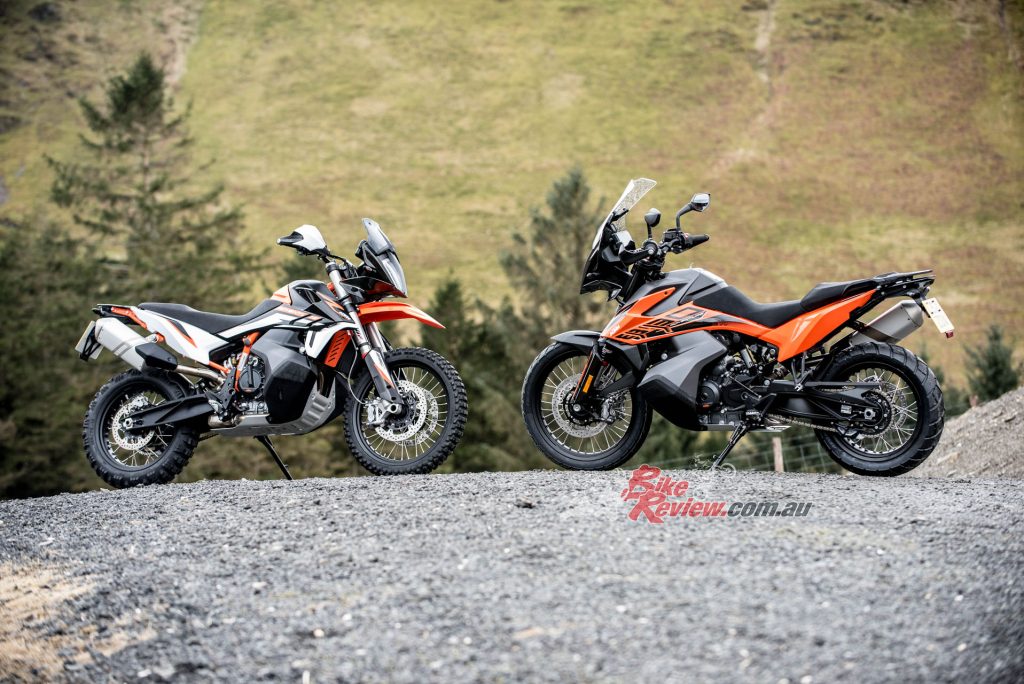
KTM returned to the drawing board after two years to redesign their 790 Adventure and do a heart transplant.
Two years on, the sunshine is just as bright but the morning air is crisp rather than baking hot, the scenery is lush Welsh hills not parched Moroccan desert, the only spectators are sheep instead of occasional camels… And the bike I’m riding looks almost identical but feels subtly more responsive as I round a turn on a gravel fire road, then crack the throttle to send the 890 Adventure R storming down the next straight section with an exhilarating, rear-tyre-spinning burst of acceleration.
Check out our KTM Adventure 790 review here…
That two-year gap before a significant update might seem short, but KTM had good reason to work fast. They needed to get the Adventures through Euro5 restrictions, so they required engine work to maintain performance, especially as the changes required for emissions would also add weight. That larger number in the model name must also help in marketing terms, too, when your closest rivals include BMW’s F 850 GS, Triumph’s Tiger 900s and even Honda’s mammoth CRF1100L Africa Twin.
Most of the updates apply to both models, which use the same DOHC, eight-valve, liquid-cooled engine, now enlarged from 799 to 889cc via increased bore and stroke that take dimensions to 90.7 x 68.8mm. The forged pistons are lighter despite being wider, compression ratio is increased, and other parts including the conrods and crankcases are revised to optimise strength and weight. Peak power is boosted to 76.8kW@8000rpm, and the maximum torque figure is 100Nm@6500rpm.
KTM also added weight to the bottom-end, increasing rotating mass by 20 per cent with the aim of improving controllability. The clutch is uprated to cope with the extra performance; the oil cooler is enlarged; the gearbox is revised with shorter lever action, toughened cogs and updated settings for the optional quick-shifter. The twin Dell’Orto throttle-bodies are fitted with a knock sensor to detect poor-quality fuel.
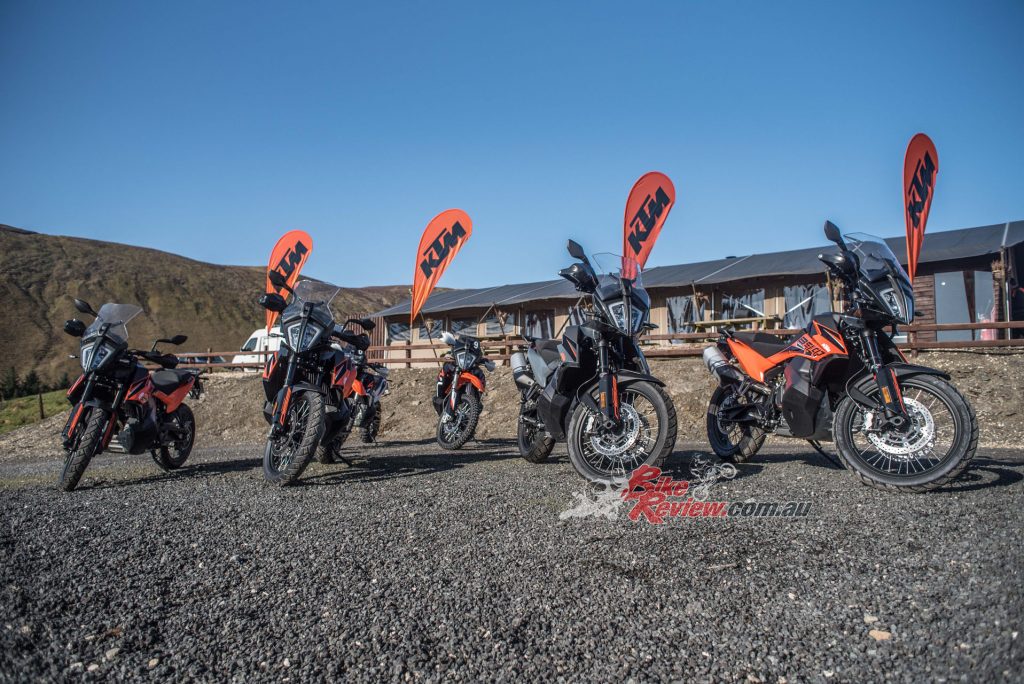
Like most Euro5 updated models, weight hasn’t been saved this year. In fact, the 890 has put on 7kg.
As before, both models also share most chassis parts, including the chrome-molybdenum tubular steel frame, which gains a new steering head tube and rear sub-frame, both made from aluminium rather than steel. Wheels remain 21in at the front, 18in for the rear for both models, and now have anodised hubs for a more durable finish; both brakes also have minor modifications. An updated electronics package features a new IMU that allows more sensitive and faster-acting TC and cornering ABS.
890 Adventure Standard
An Italian journalist got it right when he said that if KTM’s mid-sized Adventure had also been beautiful, its rivals would have been in trouble. The 790 Adventure’s sales undoubtedly suffered due to its looks, perhaps, given that much of the criticism was aimed at the bulbous pannier tanks, which contributed positively to the balance and ease of use that were among the bike’s many attributes.
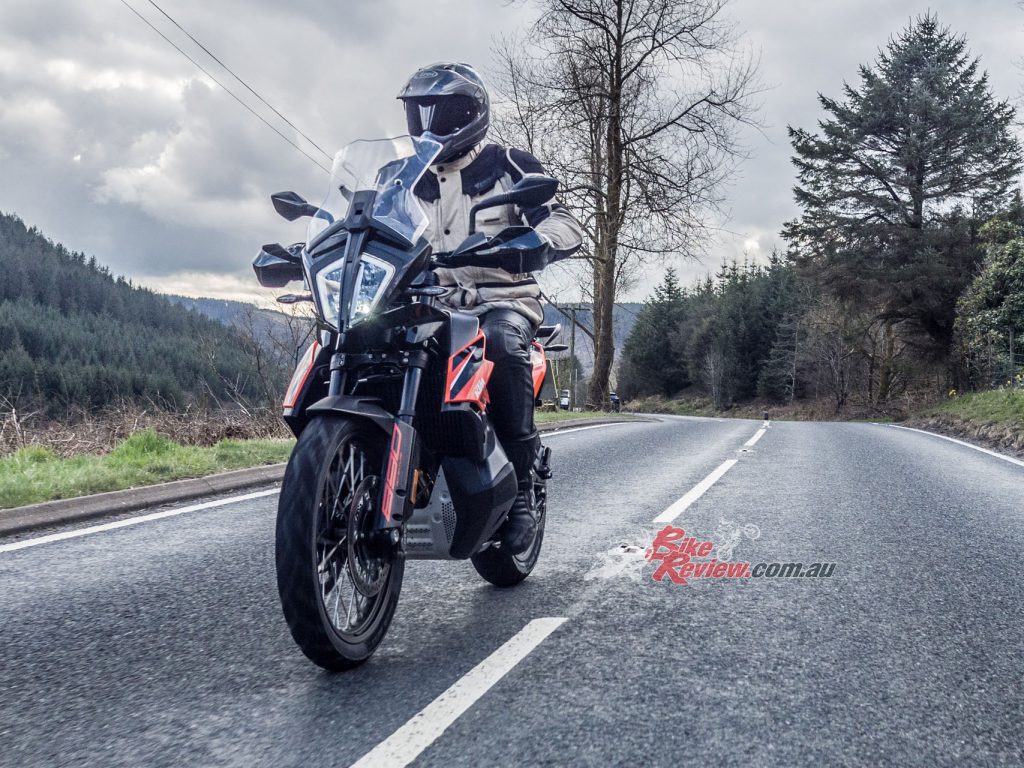
“An Italian journalist got it right when he said that if KTM’s mid-sized Adventure had also been beautiful, its rivals would have been in trouble.”
The 890 Adventure’s parallel twin has been modified in several key areas but those looks haven’t changed, bar paintwork being either all orange or black. The rider’s view of the TFT screen and typical KTM switchgear is unchanged too (though the accessory heated grips no longer require an extra switch, and there’s a cruise control button that you have to pay extra to activate). The Adventure’s manageable feel is aided by an adjustable seat that is reasonably low at 830/850mm.
The way the DOHC, eight-valve engine rumbled into life with minimal vibration thanks to its pair of balancer shafts brought back memories, but that larger, torquier unit made its presence felt as soon as I was under way. KTM’s parallel twin has always been an enjoyably responsive and grunty powerplant, the extra cubes have given it an extra dose of instant shove, without detracting from the pleasingly willing feeling at higher revs.
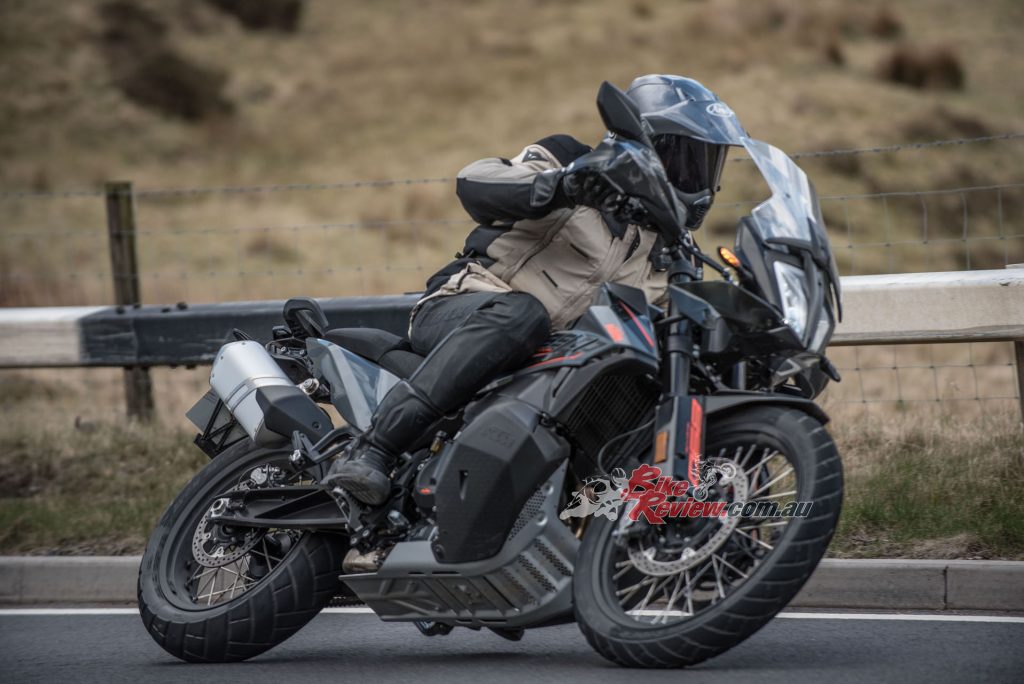
Despite its power upgrade, the 890 is still a manageable amount of torque and power for on and off the road.
Some parallel twin motors can feel slightly uninspiring even if they’re powerful but the Adventure’s certainly isn’t one of them, especially in this enhanced form. As before there are Road and Rain alternatives to the more aggressive Sport (plus an optional Rally mode), but on dry roads the 890’s sweet throttle response meant there was little motivation to use them, especially out of town.
“The 890’s extra zip was welcome almost all the time, whether it was helping the bike punch harder out of slow turns with a wider choice of gears, rev hard to put serious figures on its speedometer very quickly.”
The Adventure’s new-found heft made it quicker and more fun for our sporty solo ride, and would arguably be even more valuable when laden with luggage or even a pillion. On the open road I wasn’t too aware of the turbulence that I noted on the 790, I was satisfied by the wind protection. But on a longer or motorway trip I might have been more disappointed that KTM haven’t increased the screen’s minimal 40mm of height adjustment, and that it still can’t be done manually as on the firm’s larger models. The fact that direct rivals are no better in this respect is surely no excuse.
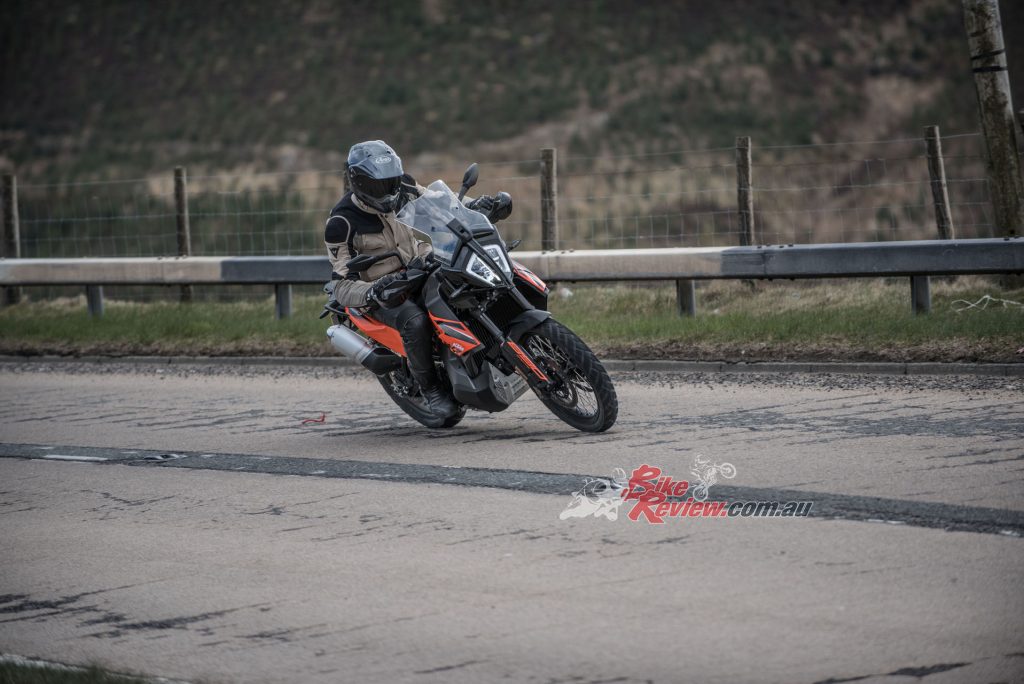
The chassis has been improved, while the changes weren’t drastic, they were enough to notice while out on the road.
On the other hand, the chassis has been improved – not dramatically, but enough to make an appreciable difference. If the standard 790 Adventure had a weakness, for me it was that it wasn’t quite as agile or refined as I’d hoped, due to its combination of 21in diameter front wheel, fairly conservative steering geometry and especially its slightly basic suspension with minimal adjustability.
The standard 890 Adventure still doesn’t have the long travel or fully-adjustable potential of the taller R model, but its WP units’ settings are slightly softer and the shock has gained a remote preload adjuster. The preload knob will be useful with a pillion, and the ability to add a bit of rear ride height and quicken the steering could be useful, but it’s probably the reworked shock that makes most difference.
When riding the 790 on bumpy roads two years ago I found its rear end distinctly harsh, with no way of improving it apart from reducing spring preload. The 890 delivered a more refined ride and was as comfortable as I’d hoped a bike with a generous 200mm of travel at each end would be, while also remaining well-damped and controllable even when the potent radial four-pot front brake calipers and capable Avon Trailrider tyres were earning their keep.
The improved ride quality boosts the Adventure’s touring potential, which is backed up by its luggage rack, decent sized pillion seat and hand-holds, and potentially by accessories including plastic or aluminium luggage plus several seat options (including higher, lower and heated).
With economy of close to 5 l/100km realistic for many riders, the unchanged 20-litre capacity is good for a genuine 300km-plus range. The standard seat should be good for that distance and more without causing complaint, though I’d need a more extensive test to be sure.
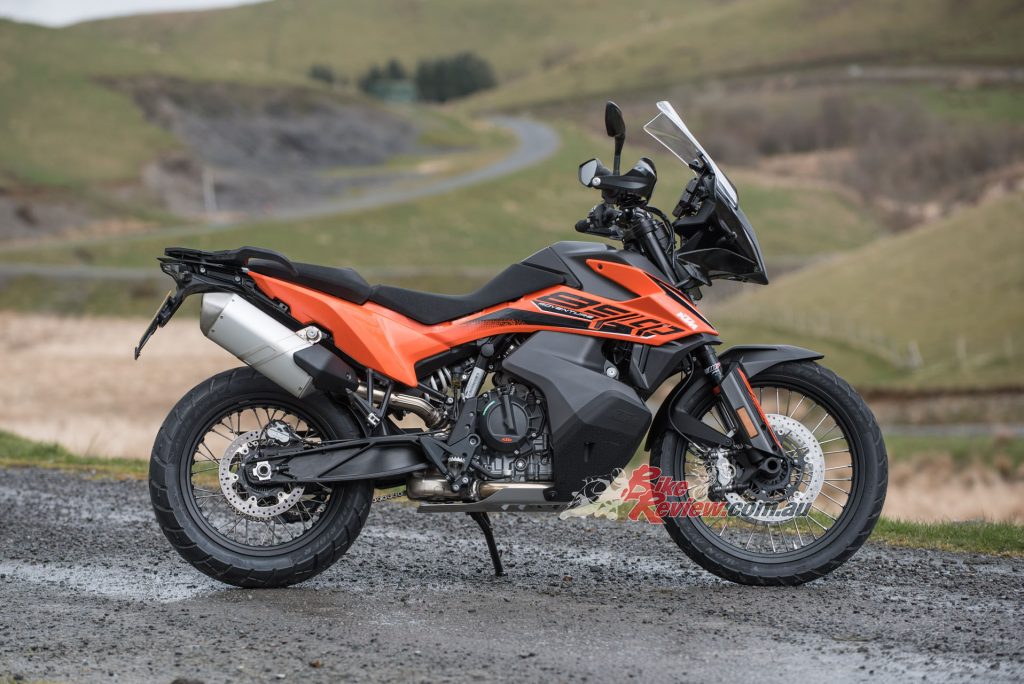
While it’s no beauty, the 890 Adventure standard model still has those great sharp KTM lines throughout it.
What is for sure is that giving the 790 Adventure a stronger engine and tweaked chassis has made a good bike better still – with no apparent drawbacks, given that its price in some markets has actually been reduced slightly. KTM’s thoughtfully uprated middleweight might still divide opinion with its looks, but anyone who dismisses the 890 Adventure without riding it will be missing out.
890 Adventure R
I’d expected KTM’s dirt-focused middleweight to be impressive on those gravel-covered Welsh fire roads, and it very much lived up to expectations. Several of the day’s most exciting moments were when winding back the throttle to send the Adventure R surging forward, its beefed-up twin-pot engine instantly responsive and its rear tyre sliding in thrilling style (while its updated traction control system stood by, just in case my enthusiasm exceeded my ability).
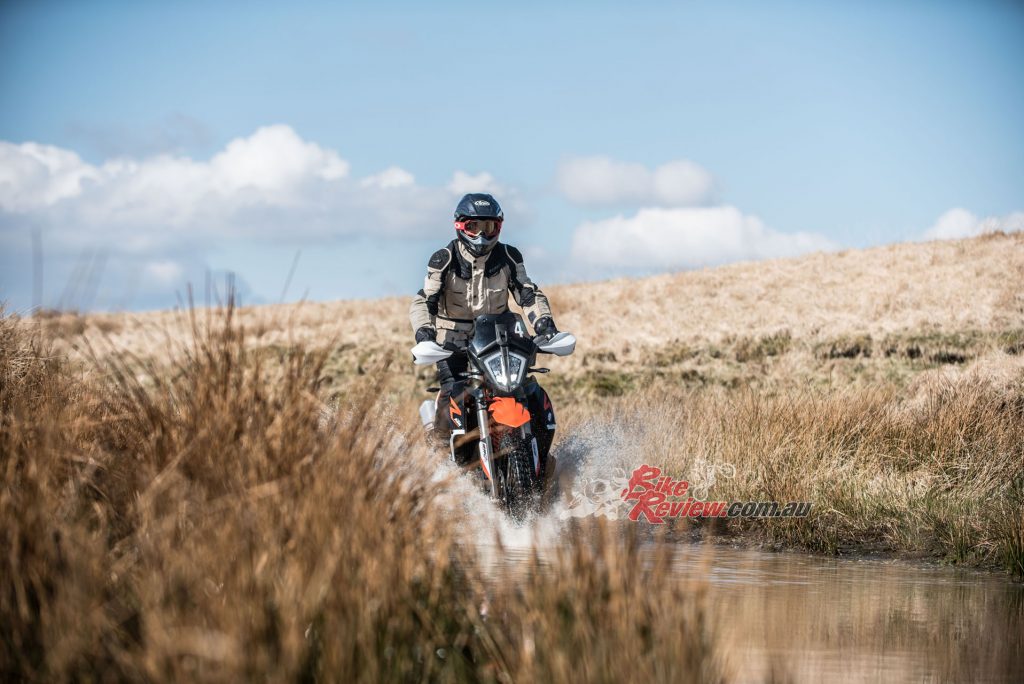
The KTM 890 Adventure R is where the party really begins, with all of KTM’s top shelf bolt ons added.
But it was at a much slower pace, on narrow tracks and slopes covered by grass, mud or occasionally water, that the 890 highlighted the more subtle yet equally important aspect of its development. With grip levels low and available torque high, the Adventure felt outstandingly responsive and controllable at low revs.
Although I’d ideally want to ride a 790 alongside it to be sure, KTM’s claim that the 20 per cent increase in rotating mass makes the larger-engined model smoother and easier to ride seemed to ring true.
Any increase in usability is welcome off-road, and KTM were starting from a very high point with the 790 Adventure R. The mid-capacity adventure class is increasingly popular for good reason, offering a tempting combination of performance, sophistication and price. With Adventure R owners more likely than most to actually ride off-road, the weight saving over a large-capacity bike is significant.
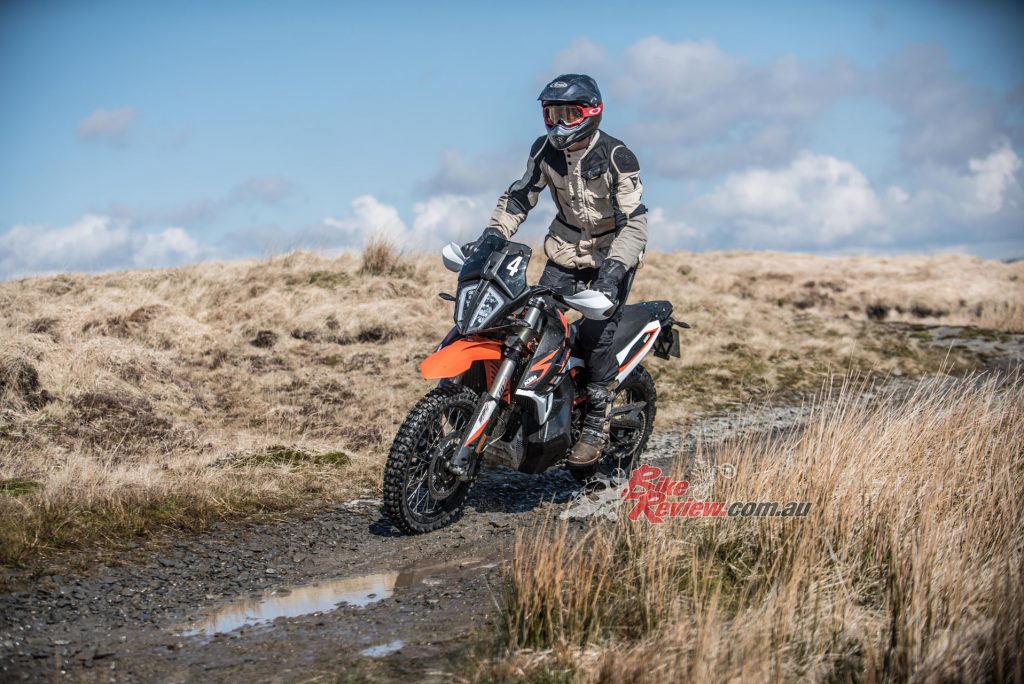
“Like the standard Adventure, the R gains 7kg in becoming the 890 so is hardly a lightweight at around 220kg with fuel.”
Like the standard Adventure, the R gains 7kg in becoming the 890 so is hardly a lightweight at around 220kg with fuel. But also like its predecessor, it is very rider-friendly and manageable, whether you’re sitting on the one-piece seat or standing up on the footrests with an even clearer view over the R-model’s stubbier screen. The KTM’s low centre of gravity helped it change direction easily in response to gentle pressure on the ‘pegs or the wide handlebar.
Inevitably the R-model’s extra off-road ability comes with some drawbacks, most obviously (for shorter riders, at least) that its one-piece, non-adjustable seat is higher, at 880mm. That’s due to WP XPLOR suspension units whose 840mm of travel means an extra 40mm at each end, and which are fully adjustable – the 48mm forks via easily used damping knobs at their tops; the shock for both high- and low-speed compression damping as well as rebound and spring preload.
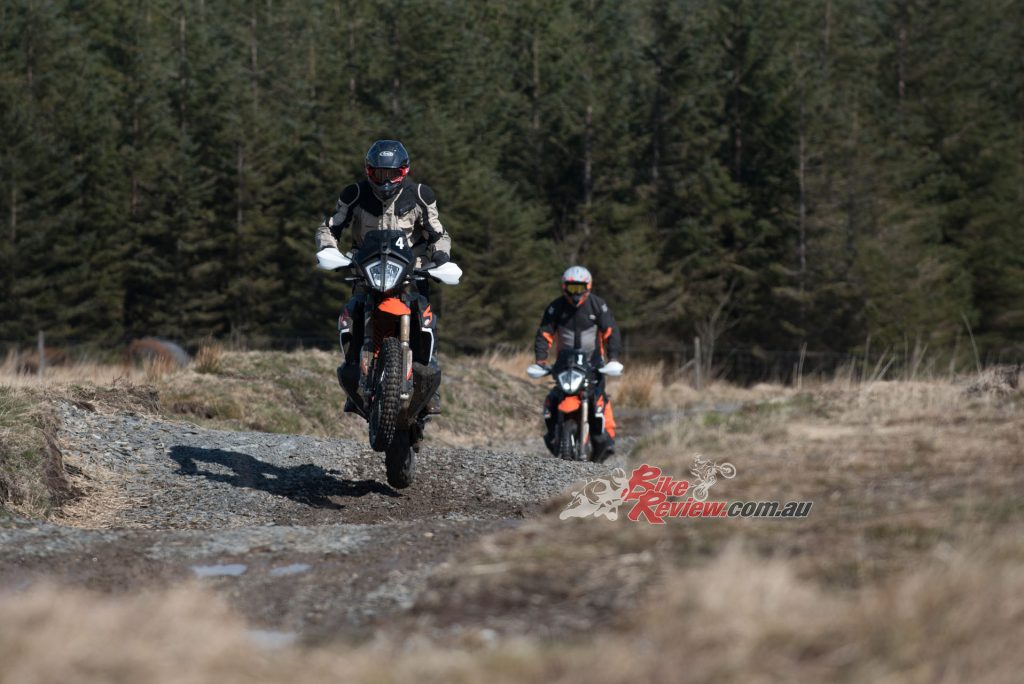
The difference between the R and standard models are small on a paved road but night and day off-road.
These are high-quality components, and helped the Adventure R cope effortlessly with everything it came up against – from clobbering bigger rocks on boulder-strewn trails, to occasionally landing crossed-up from a jump at higher speed. The fact that I didn’t need to pick up a fallen bike all day prevented my appreciating the 890’s weight advantage over a larger-engined alternative, but was testament to the way it frequently flatters its rider.
Like the standard model’s, the R-bike’s brakes have been revised to improve feedback through the lever, and its cornering ABS updated with a faster-acting IMU that also enhances the traction control. It’s a shame that, as with the standard model, you have to pay extra for the Rally mode, which allows quick adjustment of the traction control through nine levels.
On those open fire-roads the KTM was thrillingly sharp with its TC on low levels, and still felt enjoyably quick when higher TC levels meant the electronics were holding it back.
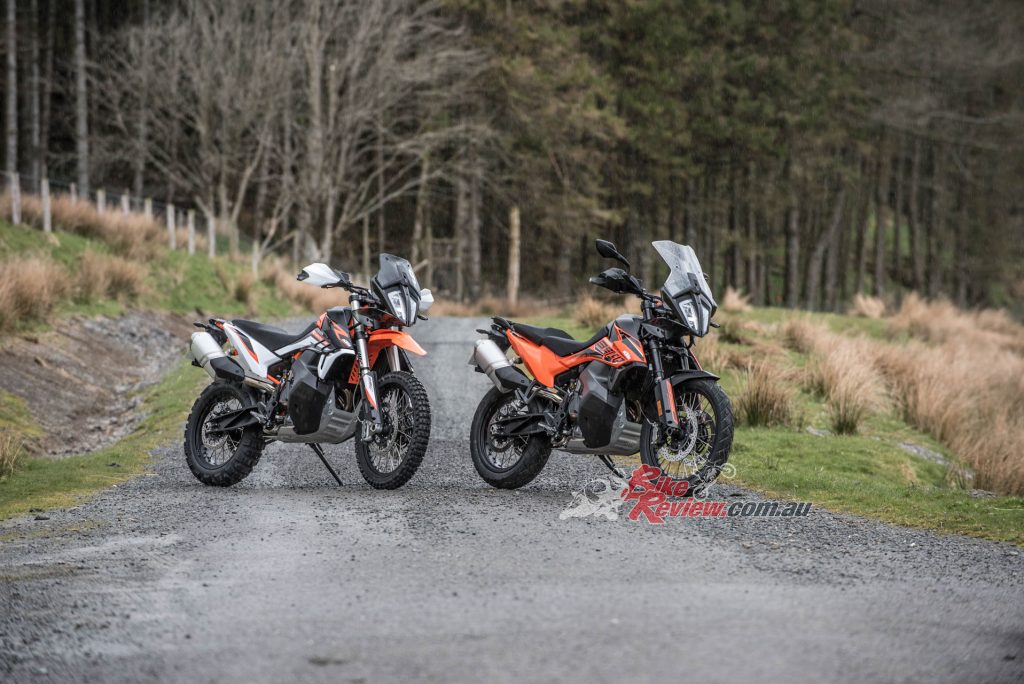
It seems like KTM have hit the mark with the engineering of the 890 Adventure, we can only pray that they amend a few aesthetic’s next time around.
I guess that’s the benefit of a torquey, 76kW-plus bike fitted with semi-knobbly Mitas E-09 tyres in place of the standard-fitment Metzeler Karoos. Chunky rubber certainly isn’t wasted on a machine as happy off-road as the 890 Adventure R. It’s roughly ten per cent more expensive than the standard Adventure, and needs more spending on those software extras (plus ideally some crash protection) to maximise its potential. The result when that’s done isn’t cheap – but is a hugely quick and capable all-rounder that highlights just what a modern middleweight adventure bike can achieve.
2021 KTM 890 Adventure (Adventure R) Specifications
Price: (From $24,300 rideaway, standard)
Warranty: Two-years unlimited km
Colours: Orange or Black
Claimed Power: 76.8kW@8,000rpm
Claimed Torque: 100Nm@6,500rpm
Dry Weight: 196kg
Fuel capacity: 20L
Engine: Liquid-cooled, four-stroke, DOHC, Parallel-twin, 90.7mm x 68.8mm bore x stroke, 889cc, 13.5:1 compression, Gearbox: Six speed Clutch: Wet, multiple disc, power assisted slipper
Chassis: Chrome-Molybdenum Tubular Steel Frame
Rake: 25.9° Trail: 107.8mm
Front Suspension: 43mm WP APEX upside-down telescopic fork, 200mm travel [48mm WP XPLOR, 240mm travel, adjustable for preload, compression & rebound damping]
Rear Suspension: WP single shock, 200mm travel (240mm travel, adjustable for preload, high- and low-speed compression & rebound damping)
Brakes: Twin four-piston radial calipers, 320mm discs with cornering ABS(f), Twin-piston caliper, 260mm disc with cornering ABS (r)
Wheels & Tyres: 2.50x21in wire spoked, 90/90 x 21in Avon Trailrider (Metzeler Karoo 3) (F). 4.50X18in wire spoked, 150/70 x 18in Avon Trailrider (Metzeler Karoo 3) (R)
Dimensions
Wheelbase: 1509mm (1528mm)
Seat height: 830/850mm (880mm)
Ground clearance: 233mm
Steering head angle: 63.7º
Instruments: Full-colour TFT dash
2021 KTM 890 Adventure Gallery


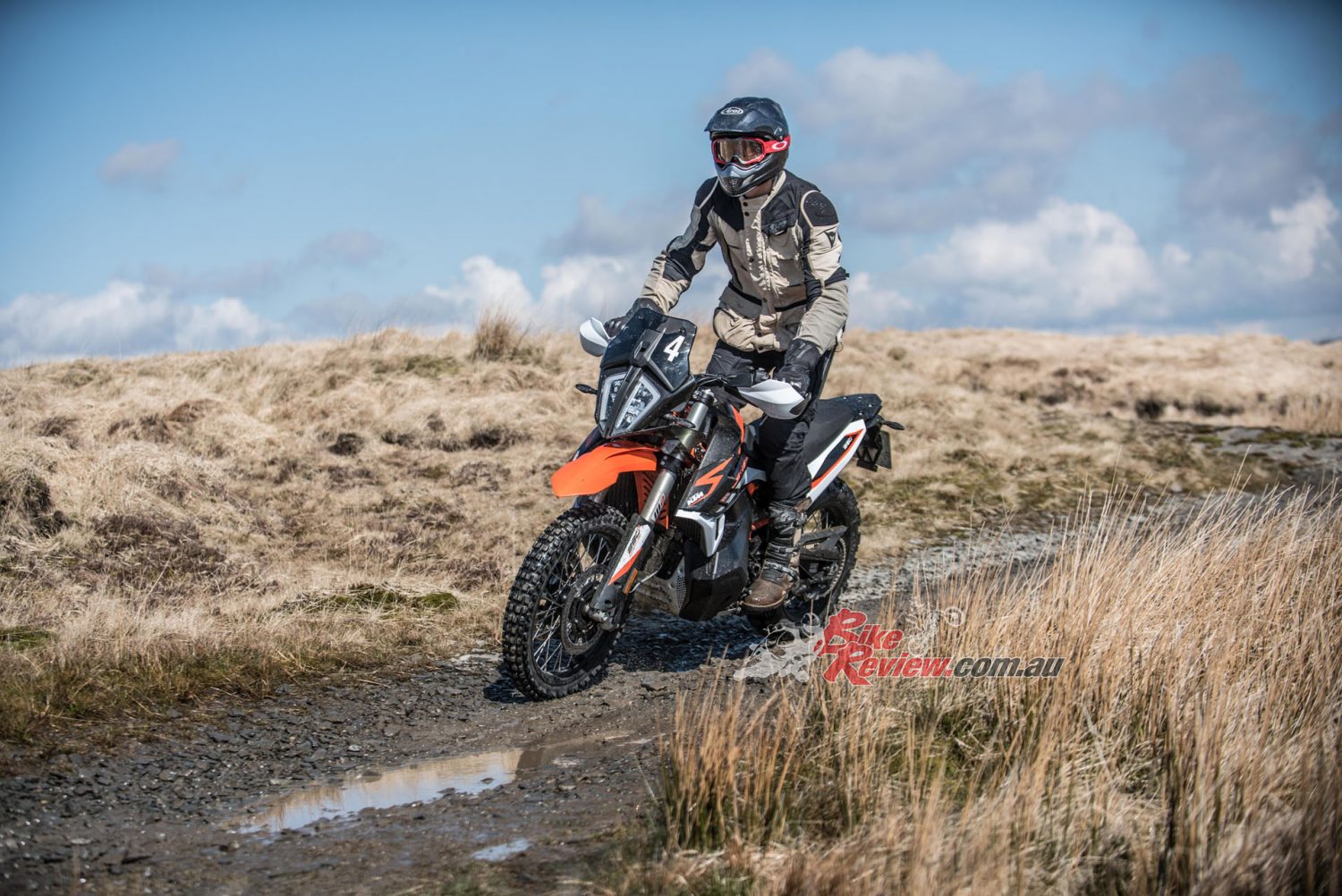
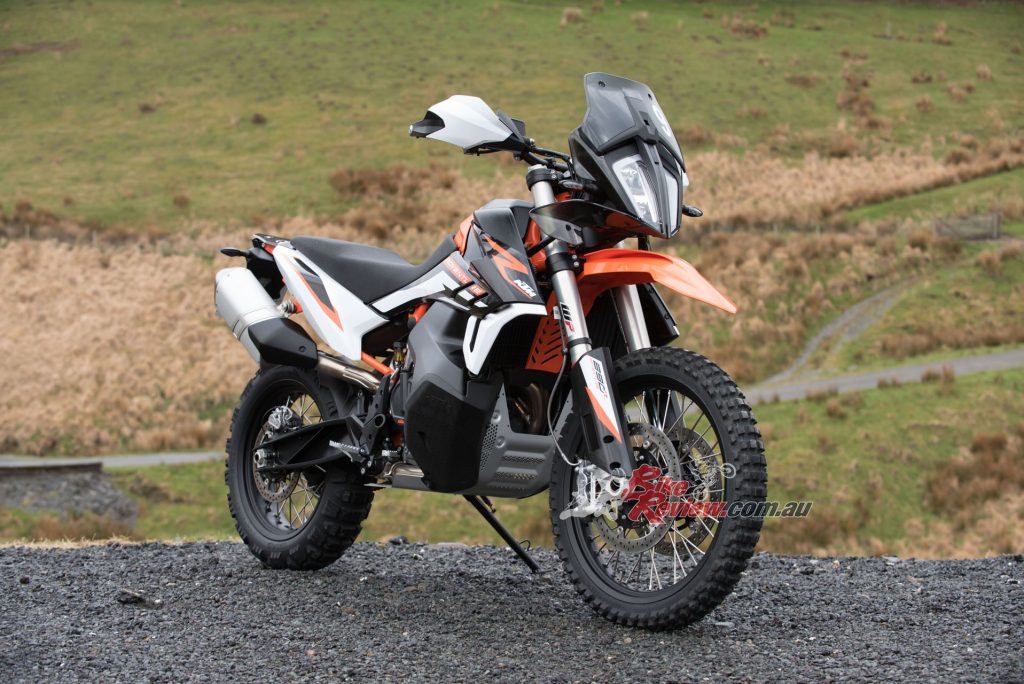
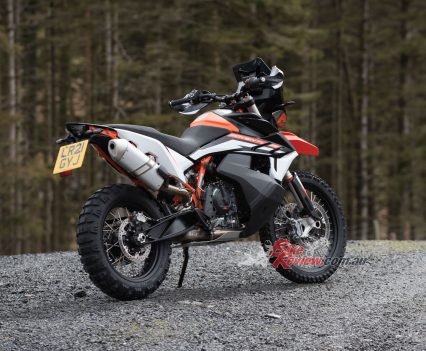
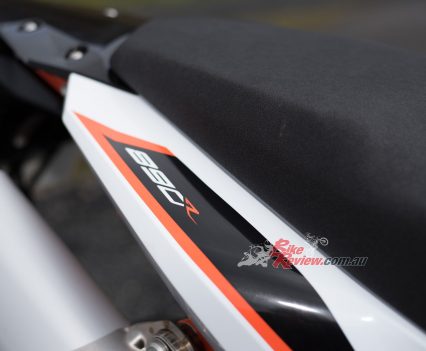

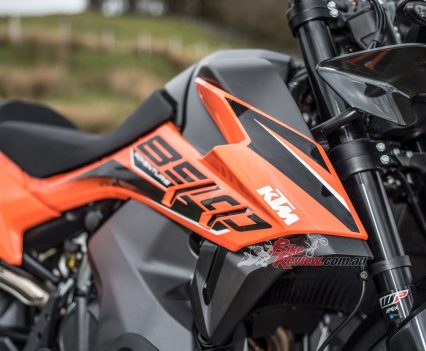
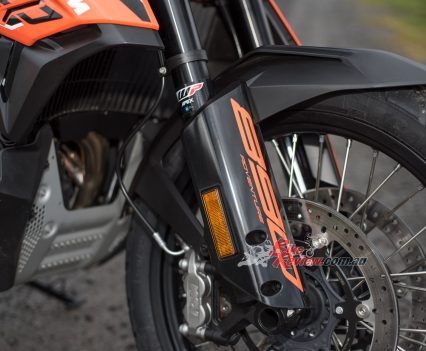
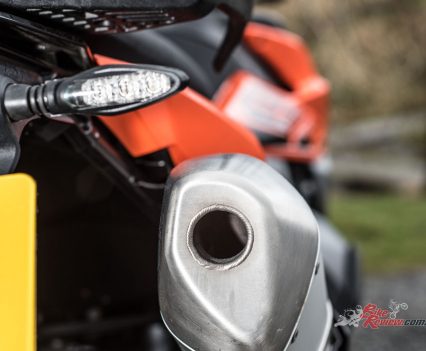
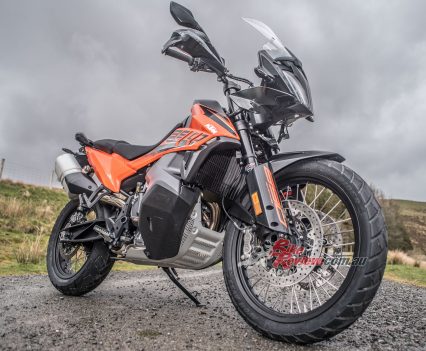
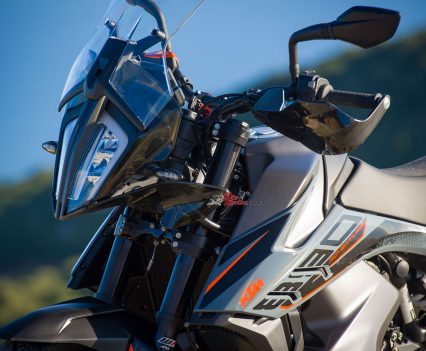
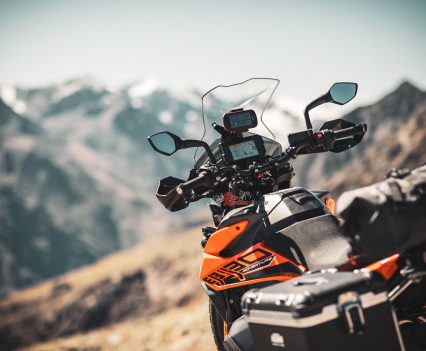
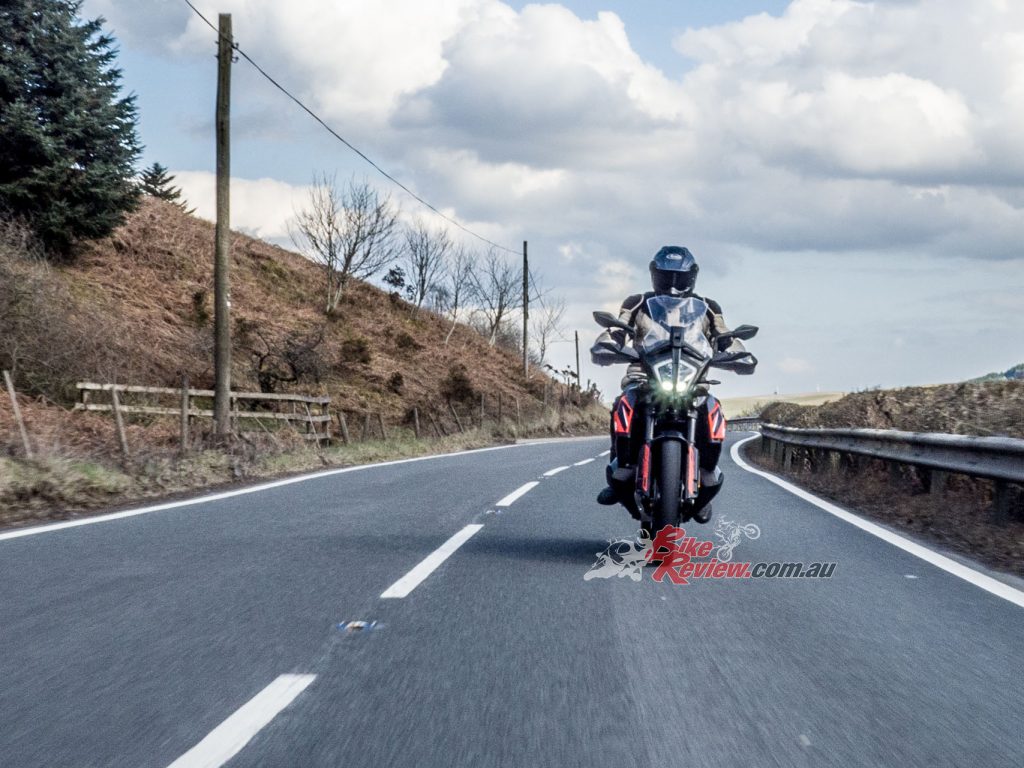
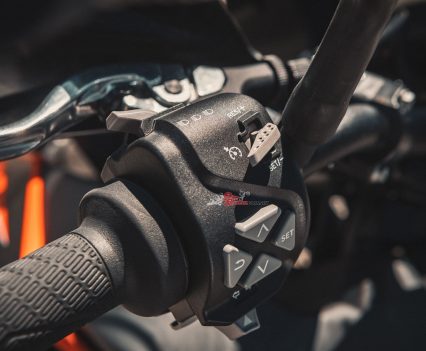
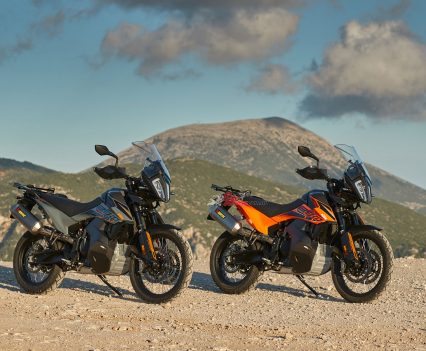
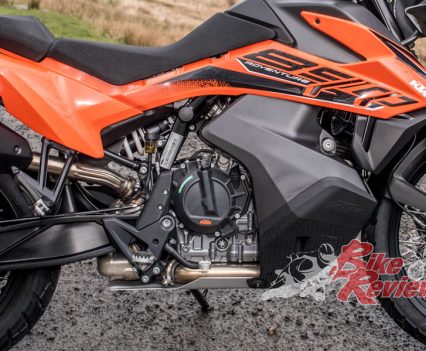
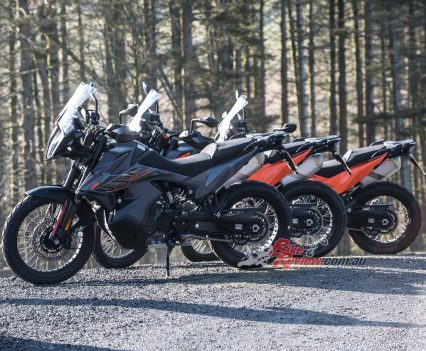



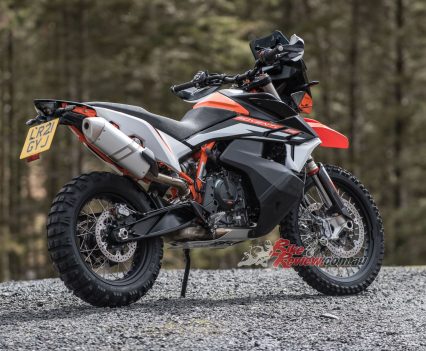
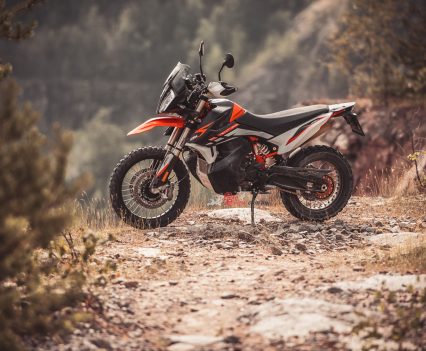
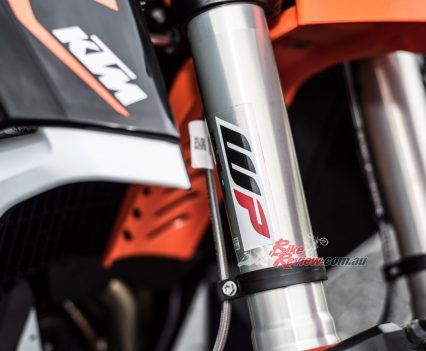
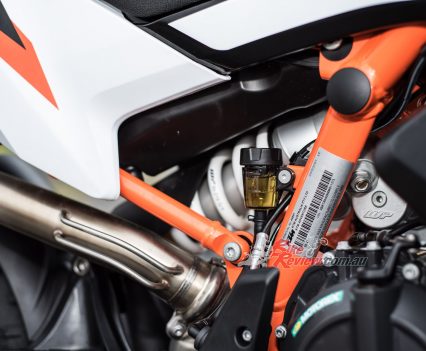
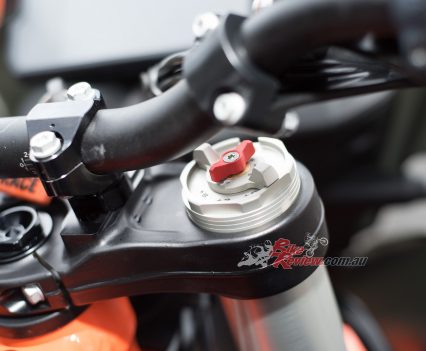
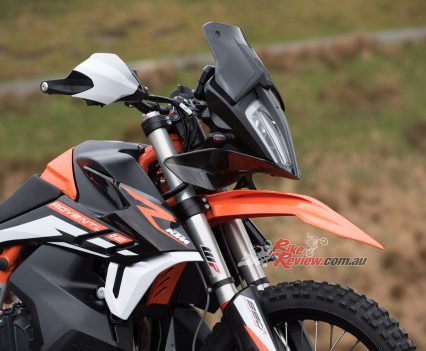
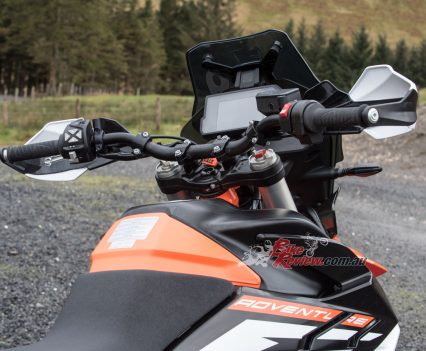
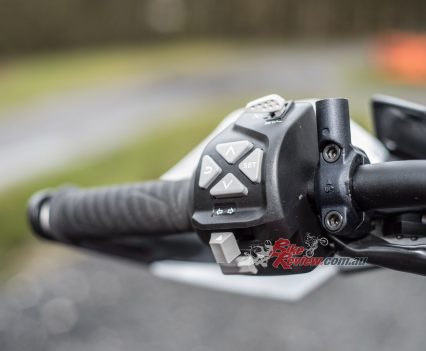
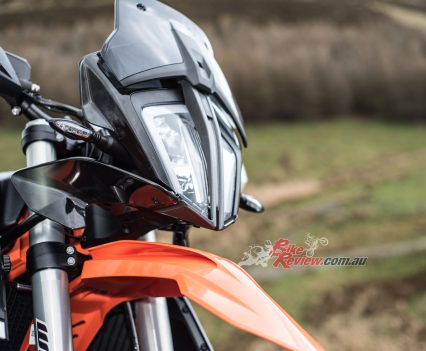



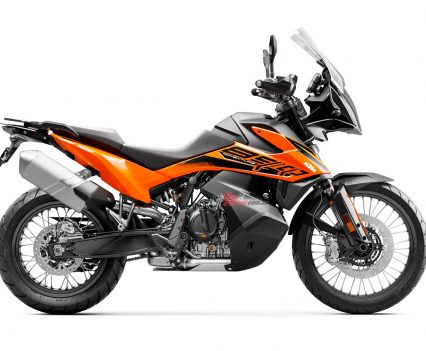
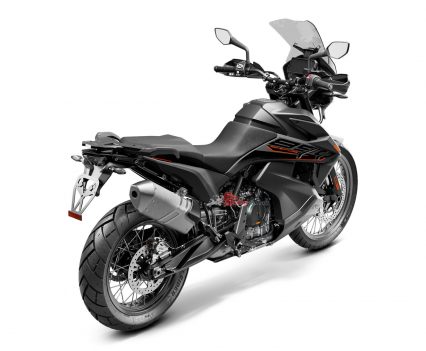
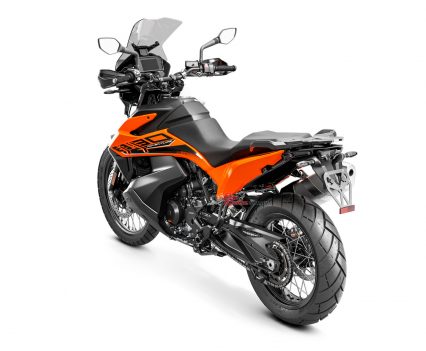
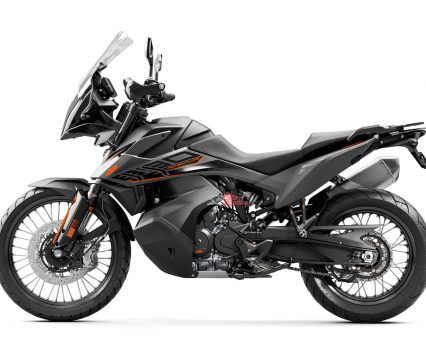
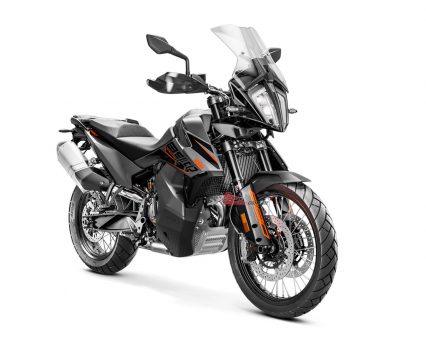
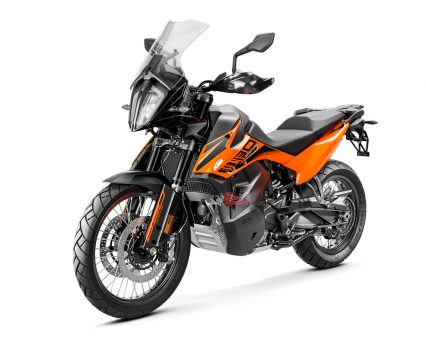
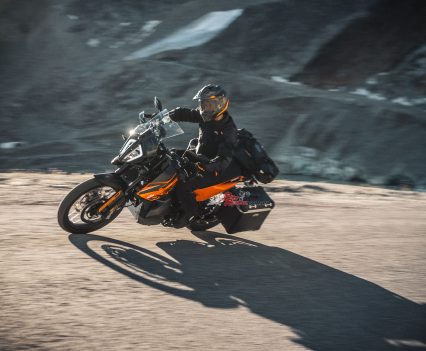
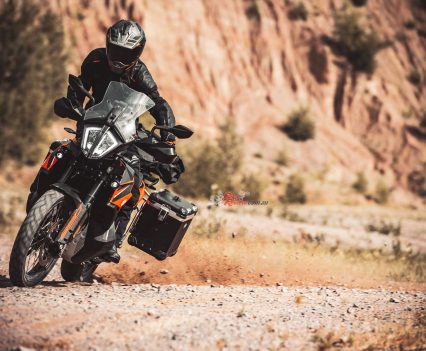
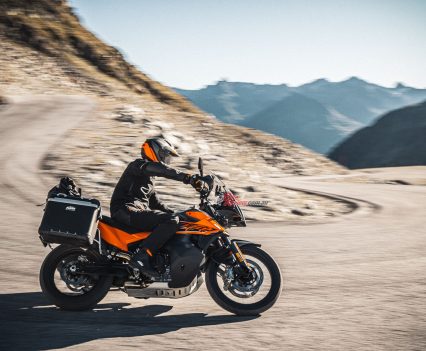
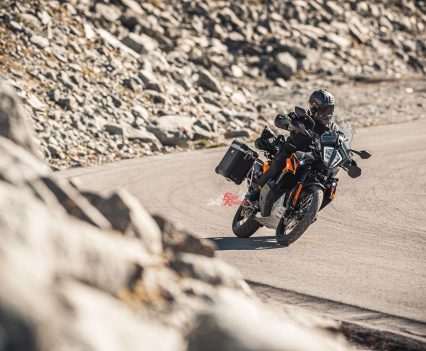
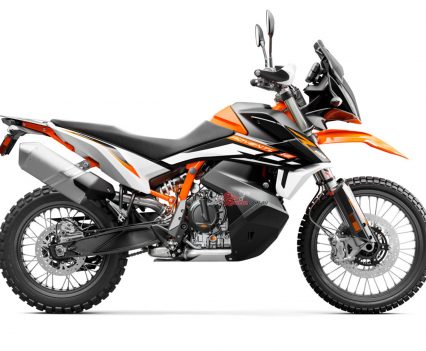
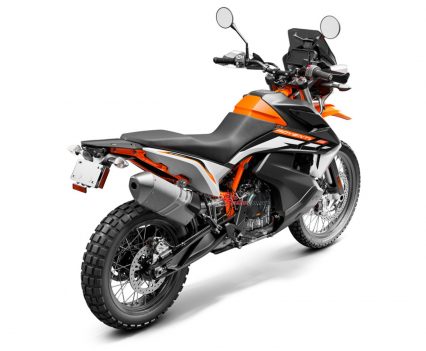
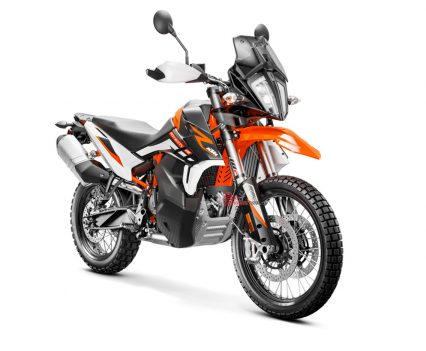
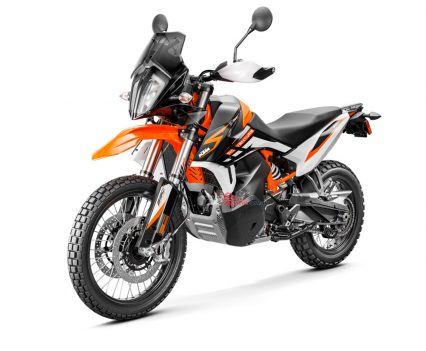

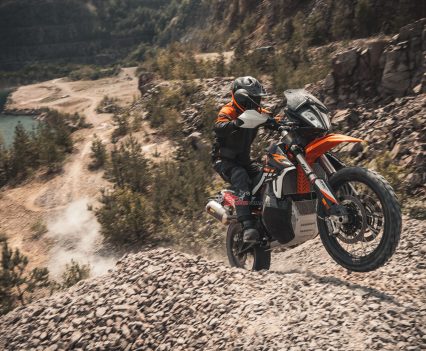
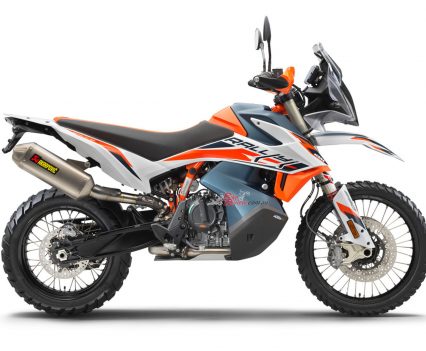
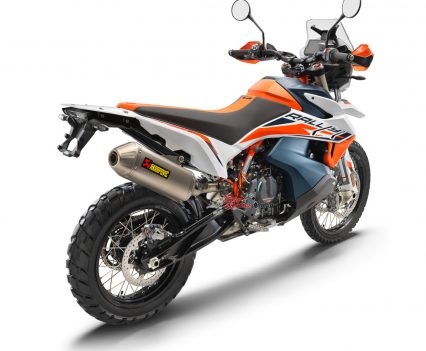
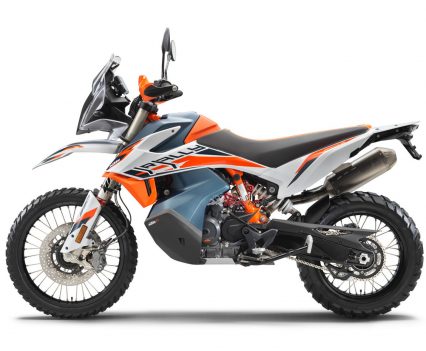
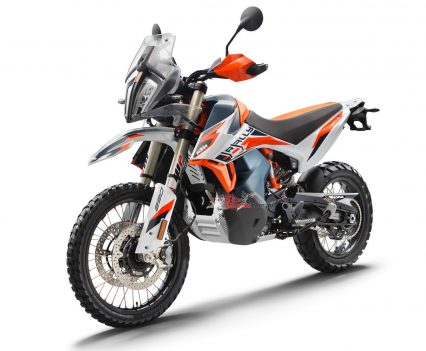
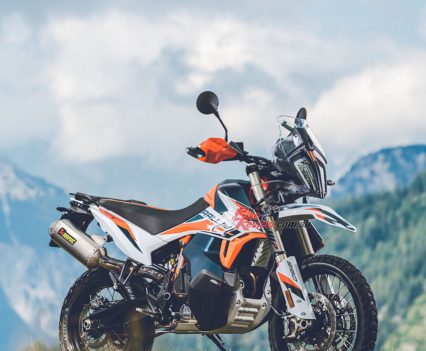
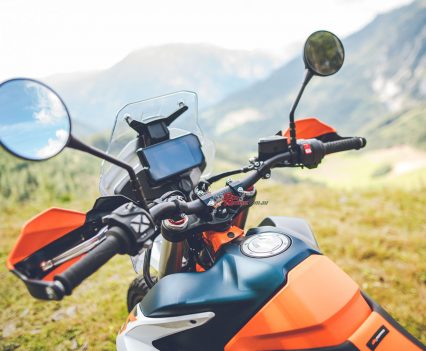
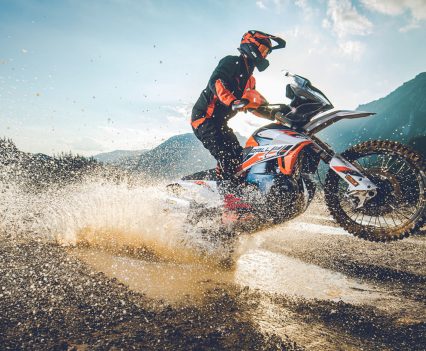
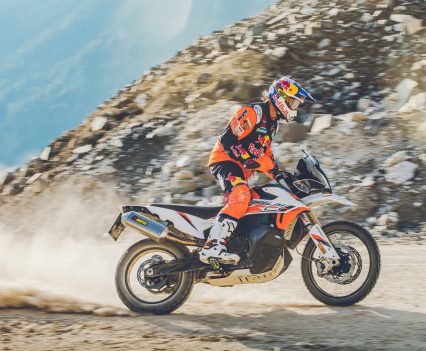
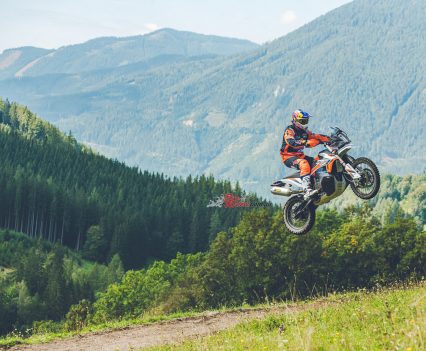
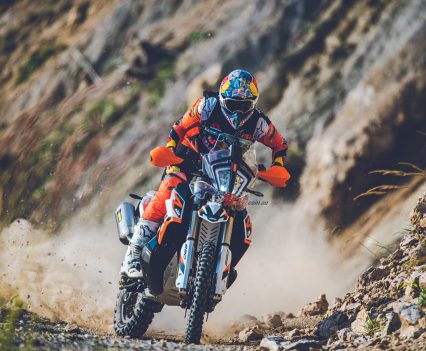
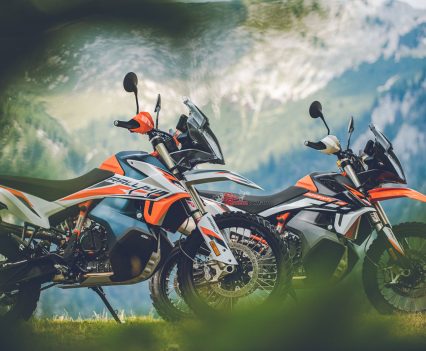
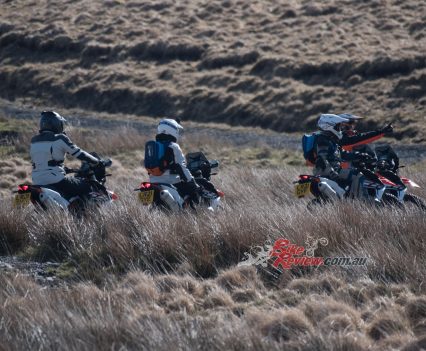
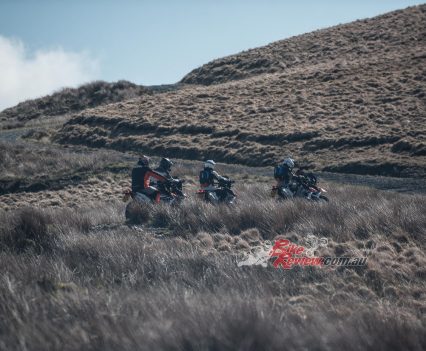
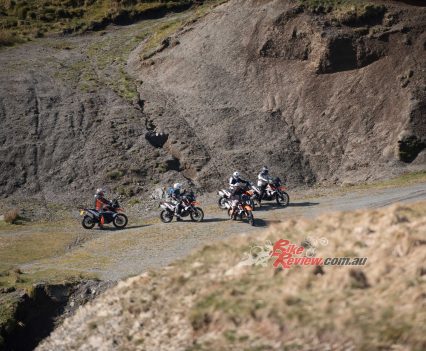
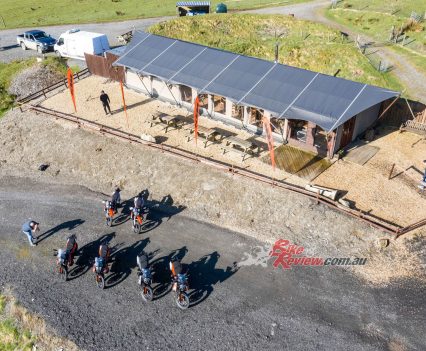

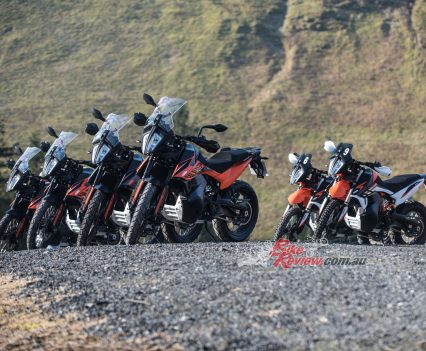
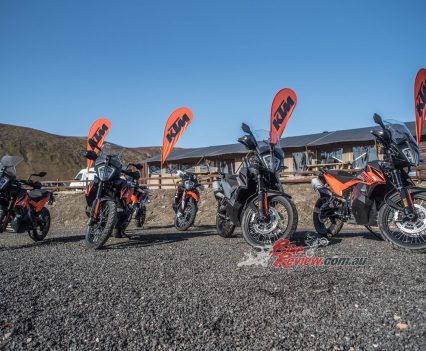
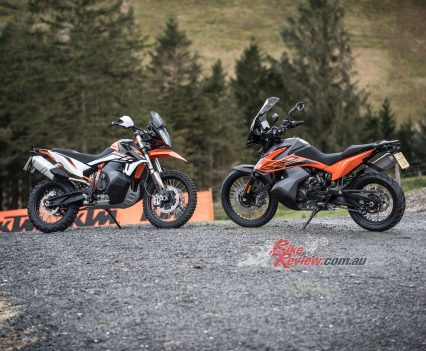
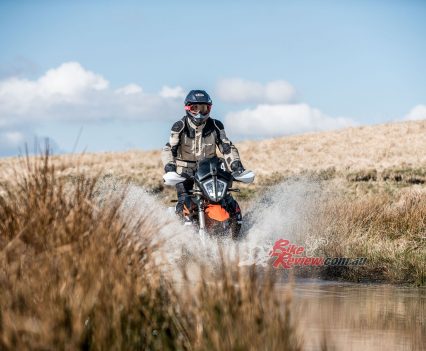
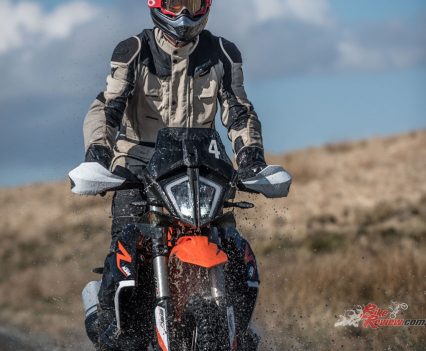
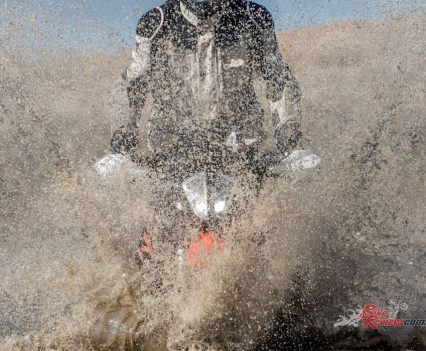
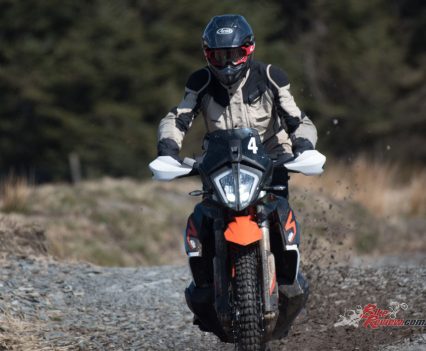
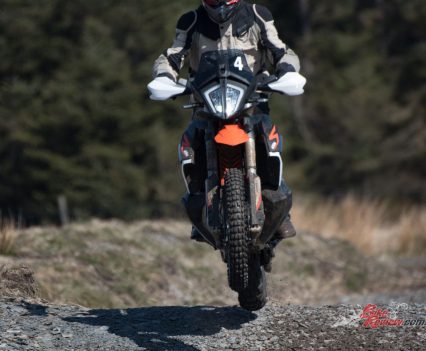
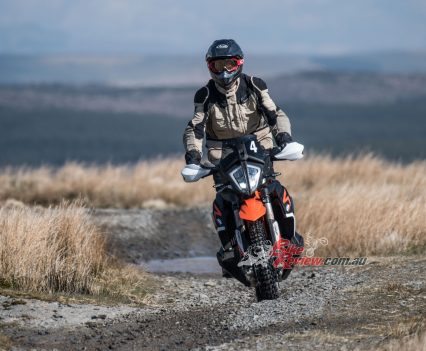
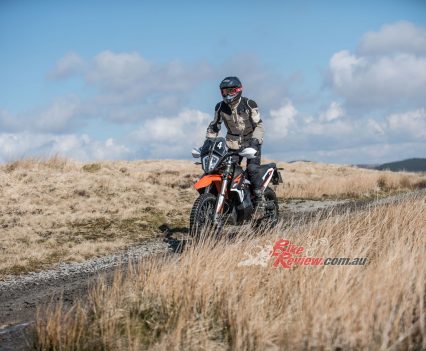
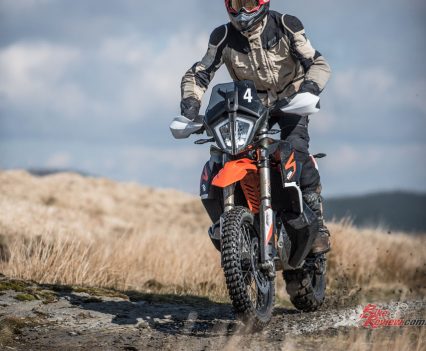
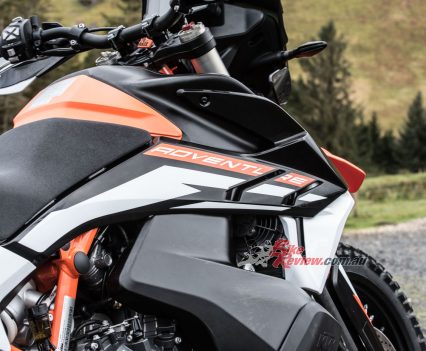

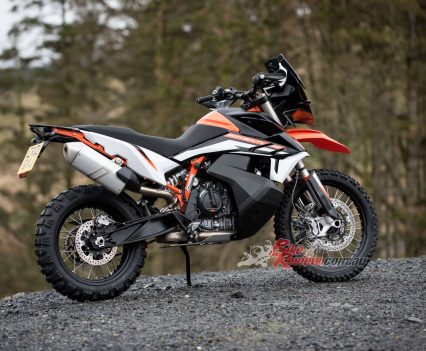
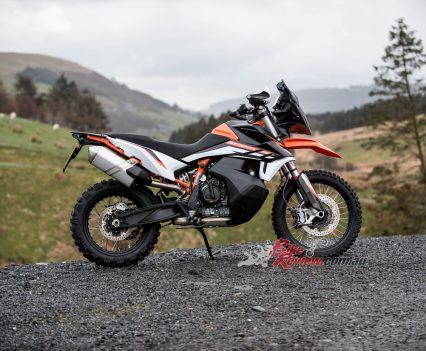
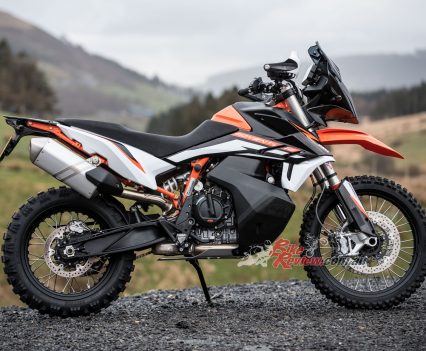
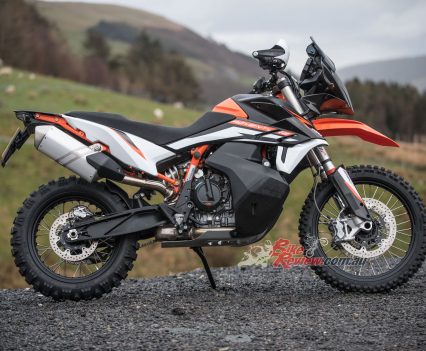
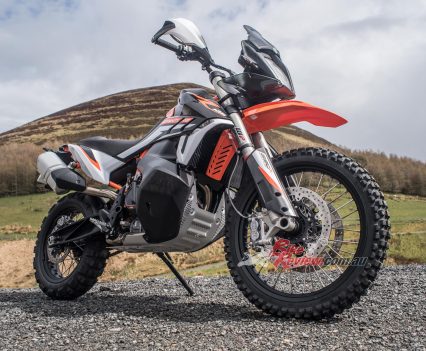
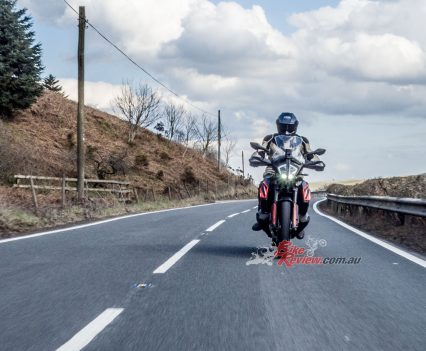
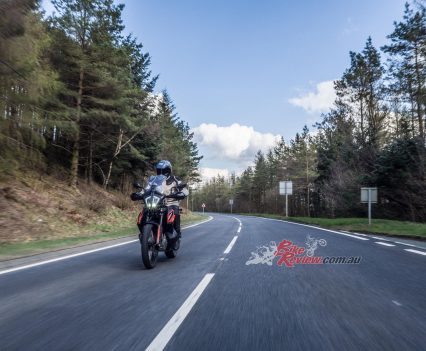
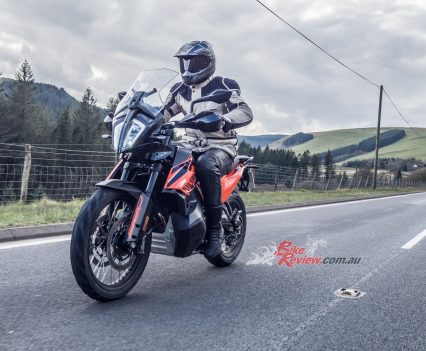
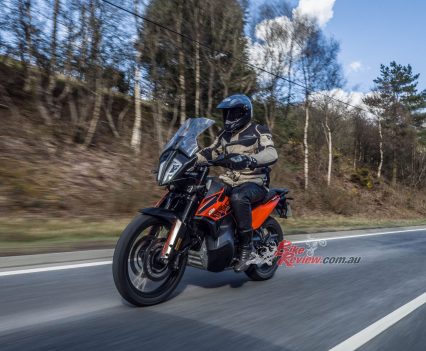
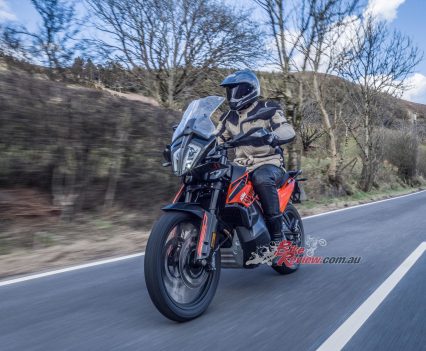
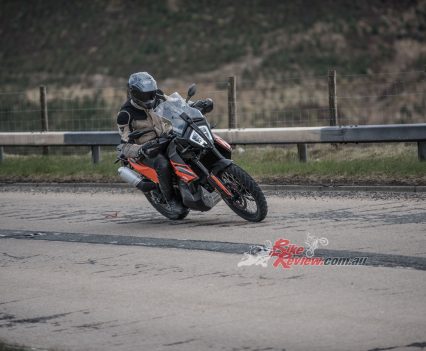
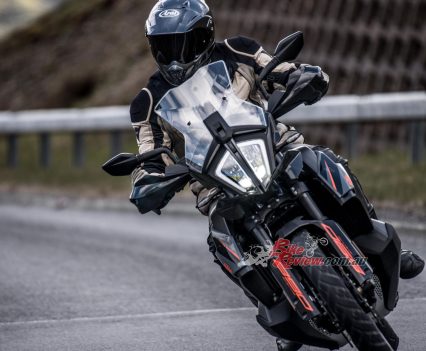
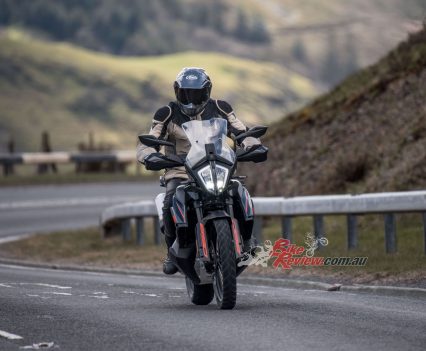
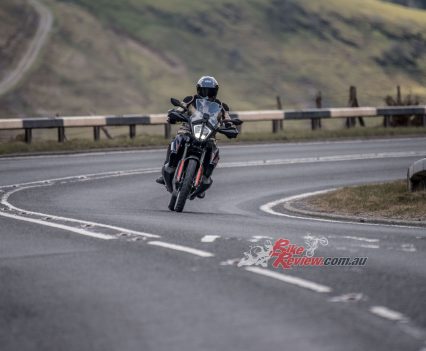
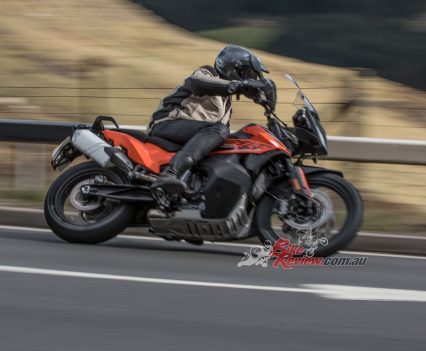
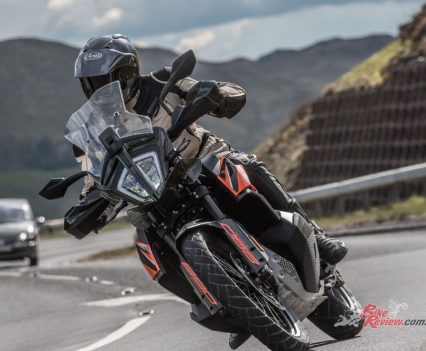
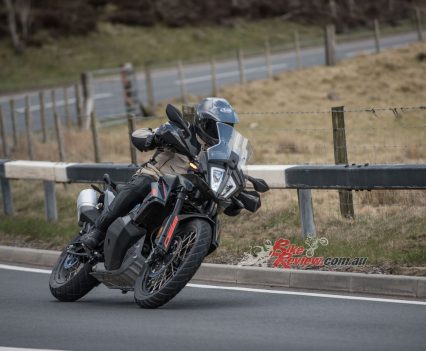
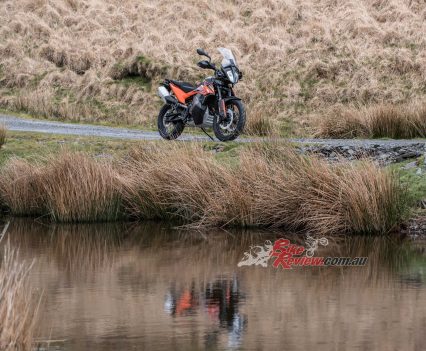
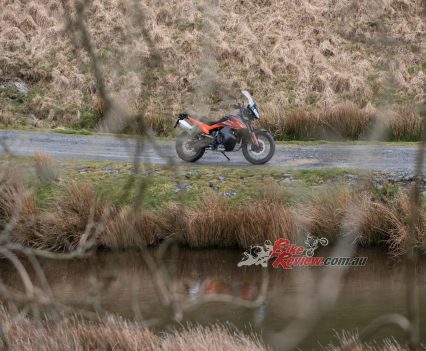
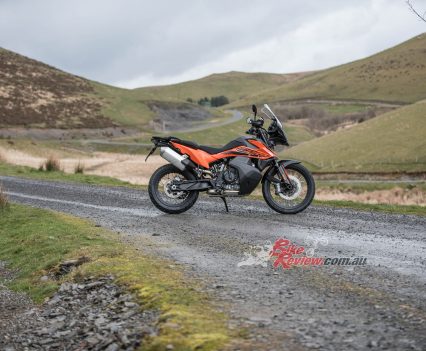
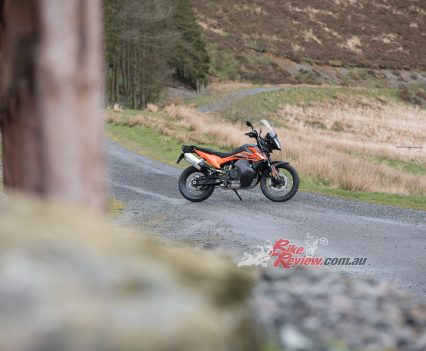

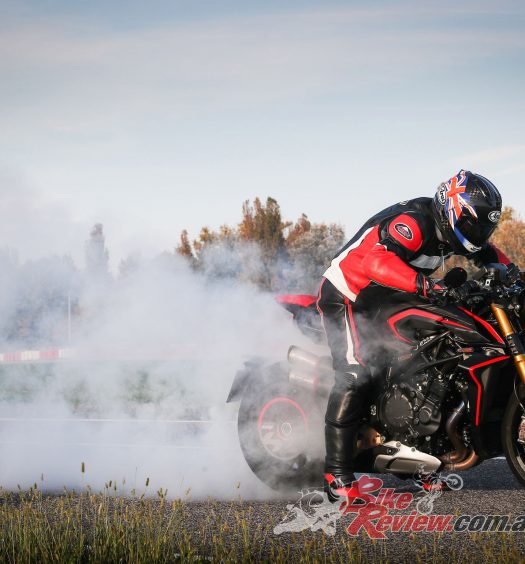
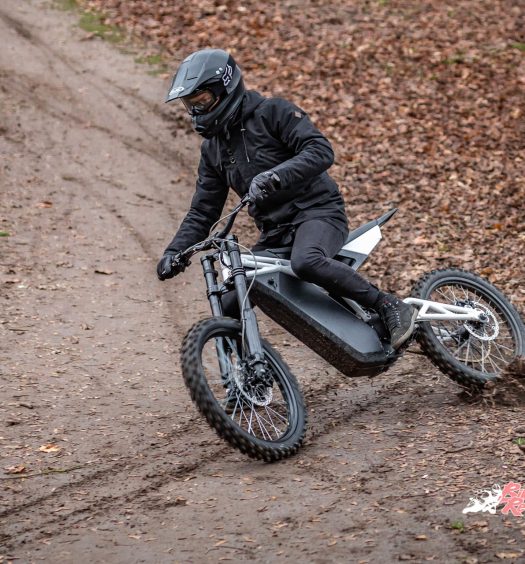
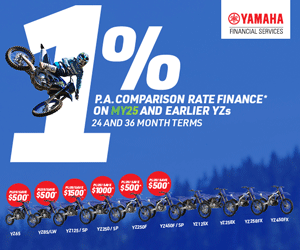



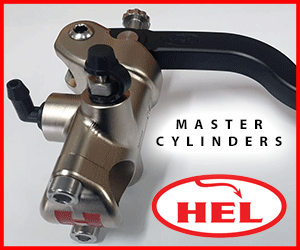
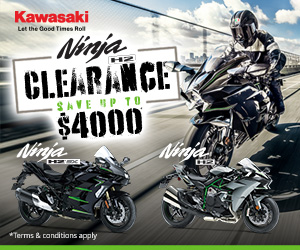







October 7, 2022
this bike with a fuel consumption of around 5L/100kms should be good for 400kms, not 300 as written above. In fact just used as a touring bike (rather than the dirt trail monster its brother the Adventure R is), my 790 ADV ridden at legal-ish highway speeds can take me 500+kms – good to know that capability is there if you find yourself “fuel challenged” during a ride.
As always it depends if the rider’s inclination is to wind the throttle on at every opportunity or just smoothly keep up a nice flow,